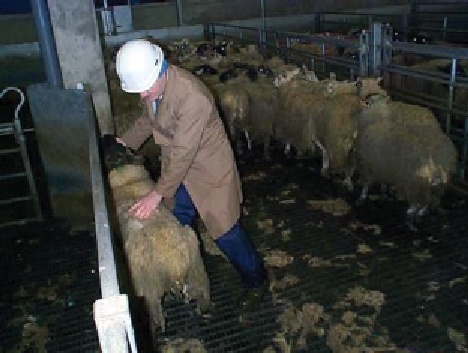Agriculture Reference
In-Depth Information
(b)
(a)
Figure 9.3
Ante-mortem inspection. (a) Taking the temperature of a suspect heifer and (b) examination of a suspect lamb (Reproduced
with permission from Harold Moore).
Practical ante-mortem procedure
Livestock in the lairage should be inspected at rest and
while in motion. Both sides of the animal should be
observed. In practice, this is simple to carry out while
the animals are being unloaded, but their excited state
during this procedure may mask some conditions
such as mild lamenesses, making a second check nec-
essary. In the case of sick or suspect diseased animals
and those in poor condition, the species, class, age,
condition, colour or markings and identification
number are recorded. The general behaviour of the
animals, whether fatigued or excited, their level of
nutrition, cleanliness, obvious signs of disease and
any abnormalities should be observed and recorded.
In addition to the segregation of diseased and suspect
stock, females in oestrus, aggressive animals and
horned stock should be isolated. If
unacceptably dirty
animals
, that is, ones which, in the opinion of the vet-
erinarian, cannot be dressed at normal line speed
without an unacceptable risk of carcase contamina-
tion, have been allowed by factory management to
enter the lairage, they must be segregated and detained
until their condition becomes more acceptable, or
they can be dressed at a line speed which decreases
the risk of contamination.
Animals showing evidence of localised conditions
such as injuries, fractures, abscesses and benign tumours
(e.g. papillomata) or conditions which will show up
lesions on post-mortem inspection need to be segre-
gated and given a detailed clinical examination. Such
animals may pass forward with the normal kill if the
condition proves to be a minor one, slaughtered at the
end of the day's kill or slaughtered separately and given a
thorough post-mortem examination.
In the case of
sick animals
, the temperature should
be taken; a rise in temperature may be the first indica-
tion of a communicable disease, although in mori-
bund animals the temperature may frequently be
subnormal. In sheep, body temperature may be a
somewhat misleading guide as, of all the food ani-
mals, its temperature is subject to the greatest daily
fluctuation; variations between 39 and 40°C are com-
mon, and in heavily woolled sheep in summer, the
temperature can vary between 38.2 and 40.1°C in
healthy animals. Pigs that show a temperature of 41°C
or over and cattle and sheep that show a temperature
of 40.5°C or higher should be isolated until the
temperature falls for, if they are slaughtered while suf-
fering from this degree of fever, the carcase will be
congested and will invariably require condemnation
(Fig. 9.3).
Animals showing signs of systemic disturbance and
an elevated temperature should not be slaughtered for
human consumption but slaughtered either in the lairage
or at the end of the day and disposed of as animal by-
product. Only on very exceptional occasions should the
animal be treated in isolation in the lairage.
It is absolutely essential that good contemporaneous
records
are kept of the ante-mortem findings. These
records must be available to the inspectors at the time of
post-mortem inspection so that the findings can be acted
upon at that stage. A system which correlates the ante-
mortem and post-mortem findings should be kept as
simple and transparent as possible. In addition, there
must be a simple method, usually
pen cards
, which allows
the lairage staff to easily identify which animals have
received ante-mortem inspection and what the outcome
has been (Fig. 9.4).


